Fermented foods have been a cornerstone of human diets for millennia, prized not only for their ability to preserve scarce resources but also for the distinctive flavors and textures they impart. Long before the advent of modern microbiology, cultures around the world discovered that allowing vegetables, grains, and legumes to undergo controlled microbial transformation could enhance digestibility, extend shelf‑life, and, as recent research increasingly confirms, support a thriving gut ecosystem. This convergence of ancestral practice and contemporary science reveals a nuanced picture: traditional fermentation techniques create complex microbial consortia and bioactive metabolites that interact with our intestinal microbiota in ways that promote health, resilience, and metabolic balance.
Traditional Fermentation Practices Across Cultures
Across continents, societies have refined fermentation methods that reflect local ingredients, climate, and cultural rituals. In East Asia, cabbage and radish are salted and packed into earthenware jars to produce kimchi, a staple that undergoes a multi‑stage lactic acid fermentation driven by *Leuconostoc, Lactobacillus, and Weissella* species. In the Korean peninsula, the timing of kimchi preparation follows the lunar calendar, aligning the fermentation temperature with seasonal shifts to achieve optimal flavor development.
In Central and Eastern Europe, cabbage is shredded, mixed with salt, and left to ferment in barrels or crocks, yielding sauerkraut. The process relies on a succession of lactic acid bacteria (LAB) that gradually lower pH, creating an environment hostile to spoilage organisms while preserving the vegetable’s nutrients.
In the Indian subcontinent, the preparation of “achar” (pickles) often involves immersing vegetables or fruits in oil, salt, and spices, then allowing spontaneous fermentation. The high salt concentration selects for halotolerant LAB and yeasts, which generate organic acids and aromatic compounds that define the pickle’s characteristic tang.
In the Andean highlands, quinoa and other grains are soaked, ground, and left to ferment in water, producing a sour porridge known as “chicha.” The natural inoculum includes *Lactobacillus* spp. and wild yeasts, which together create a mildly alcoholic, probiotic‑rich beverage.
These practices share common principles: the use of salt or acidic environments to suppress pathogens, reliance on ambient microbial flora, and a respect for the natural rhythm of fermentation. While the specific substrates and flavor profiles differ, the underlying microbial dynamics are remarkably similar, providing a universal platform for gut‑health benefits.
Microbial Communities in Traditional Ferments
Traditional fermentations are not sterile, single‑strain processes; they are dynamic ecosystems where bacteria, yeasts, and sometimes molds coexist and interact. The initial stages are typically dominated by heterofermentative LAB such as *Leuconostoc mesenteroides, which produce carbon dioxide, ethanol, and lactic acid. This early acidification creates a niche for more acid‑tolerant species like Lactobacillus plantarum and Lactobacillus brevis*, which take over in later stages and generate higher concentrations of lactic acid.
Yeasts such as *Candida spp. and Saccharomyces spp. often appear alongside LAB, contributing to flavor complexity through the production of esters, higher alcohols, and aromatic compounds. In some vegetable ferments, surface molds (e.g., Penicillium* spp.) can develop a protective pellicle that further modulates oxygen diffusion and metabolite exchange.
The diversity of these microbial consortia is shaped by raw material composition, salt concentration, temperature, and fermentation duration. Modern sequencing studies have shown that a single batch of kimchi can harbor dozens of bacterial taxa and a comparable number of yeasts, each contributing distinct metabolic pathways that collectively enrich the final product with a broad spectrum of bioactive molecules.
How Fermented Foods Influence the Gut Microbiome
When we consume fermented foods, we introduce live microorganisms—often termed “food‑borne probiotics”—into the gastrointestinal tract. While many of these microbes do not permanently colonize the gut, they can transiently interact with resident microbiota and the host epithelium, exerting several beneficial effects:
- Competitive Exclusion – Transient LAB can occupy adhesion sites on the intestinal mucosa, limiting the ability of pathogenic bacteria to establish themselves.
- Modulation of Microbial Metabolism – Fermentative microbes produce short‑chain fatty acids (SCFAs) such as acetate, propionate, and butyrate during digestion. These SCFAs serve as energy sources for colonocytes, reinforce the gut barrier, and regulate immune signaling.
- Stimulation of Indigenous Beneficial Bacteria – Certain metabolites, like lactate and bacteriocins, act as substrates or growth promoters for resident beneficial taxa (e.g., *Faecalibacterium prausnitzii*), fostering a more diverse and resilient microbiome.
- Enhancement of Mucosal Immunity – Components of fermented foods, including peptidoglycans and exopolysaccharides, can engage pattern‑recognition receptors (TLRs, NOD‑like receptors) on immune cells, promoting anti‑inflammatory cytokine production.
Collectively, these mechanisms help maintain microbial equilibrium, reduce dysbiosis, and support systemic health outcomes linked to gut integrity.
Bioactive Compounds Produced During Fermentation
Beyond live microbes, traditional fermentation generates a suite of non‑living bioactive compounds that contribute to gut health:
- Organic Acids – Lactic, acetic, and propionic acids lower the pH of the intestinal lumen, inhibiting growth of acid‑sensitive pathogens.
- Bacteriocins – Ribosomally synthesized peptides (e.g., plantaricin, nisin) possess narrow‑spectrum antimicrobial activity, targeting specific harmful bacteria without disturbing the broader microbiota.
- Exopolysaccharides (EPS) – High‑molecular‑weight polysaccharides secreted by LAB can act as prebiotic fibers, selectively feeding beneficial gut bacteria.
- Polyphenol Metabolites – Fermentation can liberate bound phenolic compounds from plant cell walls, converting them into more bioavailable forms that exhibit antioxidant and anti‑inflammatory properties.
- Vitamins – Certain LAB synthesize B‑group vitamins (e.g., B12, folate) during fermentation, augmenting the nutritional profile of the food.
These metabolites often persist after the live microbes have been inactivated by gastric acidity, extending the health impact of fermented foods throughout the digestive tract.
Evidence from Modern Clinical Research
A growing body of peer‑reviewed studies has begun to quantify the gut‑health benefits of traditional fermented foods:
- Randomized Controlled Trials (RCTs) on Kimchi – In a 12‑week RCT involving 80 adults with mild metabolic syndrome, daily consumption of 100 g of kimchi resulted in a statistically significant increase in fecal *Lactobacillus* counts, higher SCFA concentrations, and modest reductions in fasting glucose and LDL cholesterol.
- Observational Cohorts on Sauerkraut – Large‑scale epidemiological data from European cohorts indicate that individuals who regularly consume fermented cabbage have a lower incidence of colorectal adenomas, a finding correlated with higher fecal butyrate levels.
- Meta‑analysis of Fermented Vegetable Intake – A systematic review of 15 studies (total n ≈ 4,500) reported that fermented vegetable consumption is associated with a 12 % reduction in the odds of developing irritable bowel syndrome (IBS) symptoms, likely mediated by improved gut barrier function and reduced visceral hypersensitivity.
- Mechanistic Studies on Exopolysaccharides – In vitro fermentation models using human fecal inocula have demonstrated that EPS from *Lactobacillus plantarum strains isolated from traditional pickles selectively stimulate growth of Bifidobacterium* spp., enhancing acetate production and lowering luminal pH.
These findings, while still emerging, consistently point toward a synergistic relationship between the microbial and metabolite profiles of traditional ferments and a healthier, more balanced gut ecosystem.
Integrating Traditional Ferments into Contemporary Diets
For individuals seeking to harness the gut‑supportive properties of fermented foods without delving into elaborate home‑brewing protocols, several practical strategies can be employed:
- Culinary Pairings – Incorporate a modest serving (30–100 g) of kimchi, sauerkraut, or fermented pickles alongside main meals to provide a steady influx of LAB and organic acids.
- Meal Timing – Consuming fermented foods before or with fiber‑rich dishes can create a favorable environment for the transient microbes to interact with resident bacteria, enhancing prebiotic effects.
- Diverse Ferment Portfolio – Rotating between different types of vegetable ferments (e.g., radish kimchi, carrot pickles, fermented beetroot) introduces a broader spectrum of microbial strains and metabolites, supporting microbial diversity in the gut.
- Mindful Portioning – While beneficial, fermented foods are often high in sodium; balancing intake with low‑sodium fresh vegetables and adequate hydration helps maintain overall cardiovascular health.
By treating fermented foods as functional components rather than occasional condiments, modern eaters can align daily nutrition with the time‑tested wisdom of traditional cultures.
Future Directions: Bridging Tradition and Science
The intersection of ethnobotany, microbiology, and nutrition science offers fertile ground for future exploration:
- Strain‑Specific Characterization – Advanced metagenomics and metabolomics can pinpoint which indigenous strains from specific cultural ferments confer the greatest gut‑health benefits, paving the way for targeted probiotic development.
- Personalized Fermentation – Integrating individual microbiome profiles with traditional fermentation practices could enable customized recommendations, optimizing the match between consumed microbes and host ecology.
- Sustainable Production – Leveraging traditional low‑energy fermentation methods aligns with modern sustainability goals, reducing reliance on industrial processing while preserving microbial diversity.
- Clinical Translation – Large‑scale, longitudinal trials that monitor gut microbiome dynamics, metabolic markers, and clinical outcomes will solidify the causal links suggested by current evidence.
In sum, the age‑old practice of fermenting vegetables, grains, and legumes is more than a culinary curiosity; it is a biologically rich tradition that delivers a complex array of live microbes and bioactive compounds capable of nurturing the gut microbiome. By appreciating the cultural context of these foods and applying rigorous scientific inquiry, we can unlock their full potential for human health—honoring the past while advancing toward a more resilient, microbiome‑aware future.





